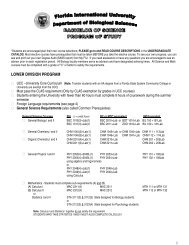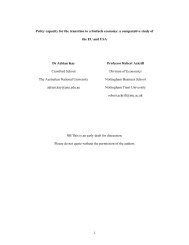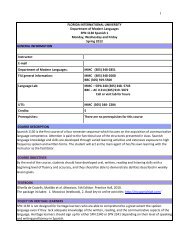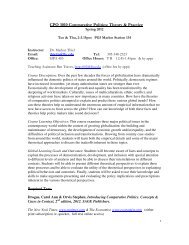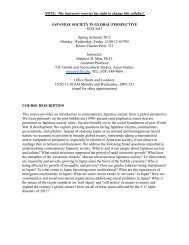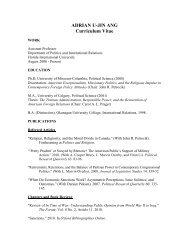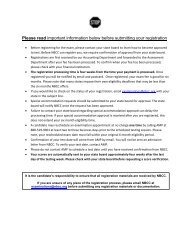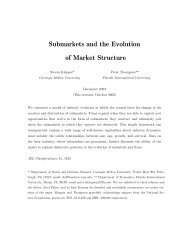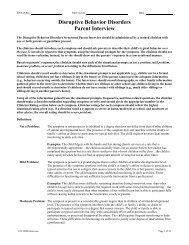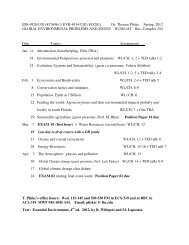South Florida Workforce Housing Best Practices
South Florida Workforce Housing Best Practices
South Florida Workforce Housing Best Practices
Create successful ePaper yourself
Turn your PDF publications into a flip-book with our unique Google optimized e-Paper software.
B. The Municipal Scorecard for Affordable <strong>Housing</strong> Delivery©<br />
The Municipal Scorecard for Affordable <strong>Housing</strong> Delivery© (MS-AHD)<br />
model was created to provide a systematic and comprehensive<br />
approach toward the policy development, implementation and<br />
performance evaluation of workforce/affordable housing initiatives at the<br />
local level. The expectation is that in order for local governments to<br />
address the urgency, complexities and long-term commitment to<br />
workforce/affordable housing issues there is the need to institute a<br />
systematic, comprehensive and performance-based approach.<br />
The MS-AHD’s systematic and comprehensive approach is a “strategy”<br />
linked to a set of objectives (processes) and measures to evaluate<br />
performance (outcomes). The initial application of the MS-AHD model<br />
identified and mapped the lead indicators (processes) and guideposts<br />
to determine the extent to which local governments in <strong>South</strong> <strong>Florida</strong> had<br />
adopted systematic and comprehensive approaches to their<br />
workforce/affordable housing needs. The identification and mapping of<br />
lead indicators that serve as the “drivers” of performance is the critical<br />
first step in performance evaluation as lead indicators are predictive in<br />
nature.<br />
The following are the guiding principals of the MS-AHD model:<br />
1) Each municipality has a “resident workforce” that is integral to<br />
the character of each community and a “commuter workforce”<br />
that supports the local economy;<br />
2) The creation of an effective response to workforce/affordable<br />
housing needs requires solutions being developed and<br />
implemented at both the municipal and county levels of local<br />
government;<br />
3) An effective policy response will necessitate a coordinated and<br />
integrated approach to affordable housing production and<br />
preservation;<br />
4) Current federal and state programs are insufficient both in terms<br />
of funding and lack of coordination and integration with other<br />
important government layers that control or influence the<br />
delivery of affordable housing, including land use planning,<br />
zoning and community redevelopment activities; and<br />
5) Local workforce/affordable housing programs and initiatives<br />
must be performance-driven.<br />
Methodology<br />
The MS-AHD model consists of four (4) interrelated and mutuallysupporting<br />
workforce/affordable housing delivery “process criteria.” The<br />
four processes provide the basis for a systematic and comprehensive<br />
workforce/affordable housing delivery system. Together these<br />
processes aim to provide the essential policy skills and leadership,<br />
management commitment, dedicated funding and on-going institutional<br />
capacity-building to enable the successful development and<br />
implementation of a sustainable workforce/affordable housing delivery<br />
system. Further, the MS-AHD serves as a performance measurement<br />
tool that can evaluate the effectiveness of a municipality in designing<br />
and implementing a workforce/affordable housing delivery system. The<br />
expected outcome of this approach (strategy) should be a sustained<br />
level of workforce/affordable housing production and preservation.<br />
The Municipal Scorecard for<br />
Affordable <strong>Housing</strong> Delivery© Model<br />
Policy & Management<br />
Institution Building Planning & Land Use<br />
Dedicated Funding<br />
The MS-AHD methodology involves an assessment of current policies,<br />
plans and other initiatives that each municipality has adopted to<br />
address their workforce/affordable housing needs and issues. The<br />
assessment includes a review of each municipality’s Comprehensive<br />
Plan and recent Comprehensive Plan Evaluation and Appraisal Report<br />
(EAR). The review also includes HUD-Consolidated Plans, Local<br />
<strong>Housing</strong> Assistance Plans (LHAPs) and Community Redevelopment<br />
Area (CRA) Plans, where applicable. The methodology also includes<br />
an interview component with relevant city/town departments and<br />
agencies, including Planning and Zoning, <strong>Housing</strong> and Community<br />
Development and Community Redevelopment Agencies (CRAs).<br />
<strong>South</strong> <strong>Florida</strong> <strong>Workforce</strong> <strong>Housing</strong> <strong>Best</strong> <strong>Practices</strong><br />
1) Policy and Management Process<br />
Effective policy and professional management are inseparable in an<br />
effective affordable housing delivery system. Coherent policy direction<br />
and sound management practice are essential. Clear policy direction<br />
will include a commitment to professional management capacity and<br />
resources. Organizational and professional management capacity are<br />
important requisites for the effective planning and implementation of<br />
affordable housing strategies. An effective policy and management<br />
process for affordable housing delivery will demonstrate clear policy<br />
direction and professional management capacity resulting in<br />
measurable affordable housing production and preservation initiatives.<br />
Policy and Management Assessment<br />
The adoption of a comprehensive local workforce/affordable housing<br />
policy and the implementation of a coordinated and integrated housing<br />
management system are potential outcomes of an effective policy and<br />
management process. A comprehensive workforce/affordable housing<br />
policy must specifically address each of the other interrelated elements<br />
of the MS-AHD model – Planning and Land Use, Dedicated Funding,<br />
Institution Building. Therefore, the MS-AHD policy and management<br />
assessment would first determine whether a comprehensive and<br />
overarching workforce/affordable housing policy has been adopted, and<br />
secondly, whether the necessary professional management resources<br />
have been inputted to effectively support the implementation of the<br />
workforce/affordable housing policy.<br />
Absent a comprehensive local workforce/affordable housing policy, the<br />
MS-AHD assessment targets a municipality’s various housing subpolicies<br />
- HUD Consolidated Plan, Comprehensive Plan and<br />
Community Redevelopment Plan. The coordination and integration of<br />
these planning policies, including their level of management capacity,<br />
are critical in the State of <strong>Florida</strong> as together these plans currently<br />
determine the extent of workforce/affordable housing production and<br />
preservation at the municipal level.<br />
2) Planning and Land Use Process<br />
Effective planning and land use will contribute to both policy formulation<br />
and strategy implementation in an affordable housing delivery system.<br />
Planning will inform policy and then create appropriate land use<br />
changes to promote affordable housing development opportunities. As<br />
such, the MS-AHD model determines whether planning is being used<br />
as a vehicle for informing affordable housing policy decisions and a<br />
means for implementing affordable policy strategies. An effective<br />
planning and land use process for affordable housing delivery will also<br />
integrate workforce/affordable housing with related planning initiatives<br />
involving economic development, transportation and capital<br />
improvements.<br />
2




